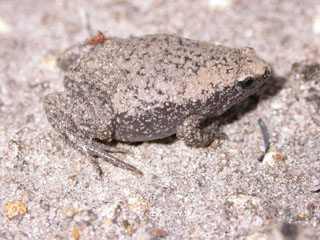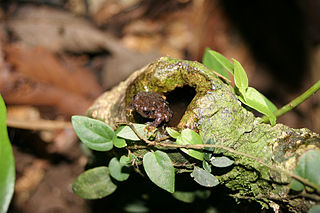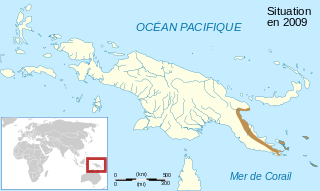
The Microhylidae, commonly known as narrow-mouthed frogs, are a geographically widespread family of frogs. The 683 species are in 57 genera and 11 subfamilies.

Cophylinae is a subfamily of microhylid frogs endemic to Madagascar. It has over 100 species in eight genera. Members of this subfamily range from minute to fairly large, and they are highly ecologically diverse. DNA barcode research has revealed a significant taxonomic gap in this subfamily, and an estimated 70+ candidate species were identified. Many of these have subsequently been described, as well as numerous new discoveries.

Metaphrynella is a small genus of microhylid frogs from the southern Malay Peninsula and Borneo. They are sometimes known as the Borneo treefrogs or tree hole frogs. The common name refers to the microhabitat of these frogs: males call from tree holes and tadpoles develop in the water contained in those holes.

Copiula guttata is a species of frog in the family Microhylidae. It is endemic to Papua New Guinea and known from around the head of the Gulf of Papua in the Gulf and Chimbu Provinces. The specific name is the Latin adjective guttata that means "spotted" and refers to the dorsal colour pattern of this species. Based on molecular evidence, it was transferred from Austrochaperina to Copiula in 2016.

Copiula rivularis is a species of frog in the family Microhylidae. It is endemic to Papua New Guinea and known from near the Indonesian border east to the Morobe Province; it is expected to occur in the Papua province of Indonesia. The specific name comes from the Latin adjective pertaining to small brooks or streams and refers to the habitat of this species. Based on molecular evidence, it was transferred from Austrochaperina to Copiula in 2016.
Chiasmocleis anatipes is a species of frog in the family Microhylidae. As currently known, it is endemic to northeastern Ecuador, but it is likely to occur also in adjacent parts of Peru and perhaps Colombia too. The specific name anatipes refers to the "duck-like" feet of this frog, characterized by extensive webbing between the toes. Common name Santa Cecilia humming frog has been proposed for this species.

Chiasmocleis hudsoni, also known as Hudson's humming frog, is a species of frog in the family Microhylidae. It is found in French Guiana, Suriname, Guyana, Guianan Venezuela, Colombia (Amazonas), and Amazonian Brazil. Chiasmocleis jimi has been included in this species but the most recent genetic analyses support its recognition as a distinct species; both species might include further distinct lineages that warrant recognition as species.

Chiasmocleis ventrimaculata, also known as the dotted humming frog, is a species of frog in the family Microhylidae. It is found in Bolivia, Brazil, Colombia, Ecuador, and Peru. Its natural habitats are subtropical or tropical moist lowland forests, swamps, and intermittent freshwater marshes.

Sphenophryne thomsoni, sometimes known as Thomson's toothless frog, is a species of frog in the family Microhylidae. It is endemic to Papua New Guinea and occurs in the southeastern peninsular New Guinea, Louisiade Archipelago, d'Entrecasteaux Islands, and Woodlark Island. It was formerly in its own monotypic genus Genyophryne. The specific name thomsoni honours Basil Thomson, a British intelligence officer, police officer, prison governor, colonial administrator, and writer.

Hamptophryne is a small genus of microhylid frogs from South America. The genus was previously monotypic, but because of the close phylogenetic relationship between Hamptophryne and Altigius, another monotypic genus, the latter was placed in synonymy with Hamptophryne in 2012.

Stereocyclops histrio is a species of frog in the family Microhylidae. It is endemic to the northeastern Bahia state of Brazil where it occurs in remnants of the Atlantic forest. After the holotype was collected in 1944, the species went unrecorded until a population was found in the Una Biological Reserve and its surroundings in 1999. It is now known from four locations. Common name Bahia yellow frog has been coined for it, perhaps in reference to the bright lemon yellow coloration of the holotype. It was the only species in the genus Hyophryne until 2012 when molecular data demonstrated that it is nested within Stereocyclops species.

Nanohyla perparva is a diminutive species of frog in the family Microhylidae. It is endemic to Borneo and found in Kalimantan (Indonesia), Brunei, and Sabah and Sarawak (Malaysia). The nominal species includes distinct lineages that likely represent different species. Common names least narrow-mouthed frog and Labang forest rice frog have been proposed for this species.

Myersiella is a genus of frogs in the family Microhylidae. It is monotypic, being represented by the single species, Myersiella microps. It is endemic to southeastern Brazil and occurs in Espírito Santo, Rio de Janeiro, southeastern Minas Gerais, and southeastern São Paulo state. The genus name honors George S. Myers. The genus is sometimes known as the elongated frogs, while the sole species is known as Rio elongated frog.
Oreophryne biroi is a species of frog in the family Microhylidae. It is endemic to New Guinea and occurs on the north coast from Madang Province in Papua New Guinea to the Cyclops Mountains in Papua province, Western New Guinea (Indonesia). The specific name biroi honours Lajos Bíró, a Hungarian zoologist and ethnographer who collected the holotype. Common name New Guinea cross frog has been coined for it.
Oreophryne brachypus is a species of frog in the family Microhylidae. It is endemic to the island of New Britain, in the Bismarck Archipelago of Papua New Guinea. Common name Gazelle cross frog has been coined for it.

Aphantophryne nana is a species of frog in the family Microhylidae. It is endemic to the Philippines and is known with certainty only from the island of Camiguin. It is unclear whether similar frogs from northeast Mindanao are referable to this species. It was described as Oreophryne nana, but based on molecular data it was moved to Aphantophryne in 2017. Common names Camiguin cross frog, Camiguin narrow-mouthed frog, and volcano cross frog have been coined for the species.
Oreophryne notata is a species of frog in the family Microhylidae. It is endemic to Papua New Guinea and known from two localities, Ialibu, its type locality in the Southern Highlands Province, and Tabubil in the Western Province. It might occur more widely. The specific name notata is from Latin nota meaning a "mark" or "letter" and refers to the diagnostic U-like pattern on the lores.
Aphantophryne parkeri is a species of frog in the family Microhylidae. It is endemic to the north coast of New Guinea and only known from Matapan and the Bewani Mountains in the West Sepik Province, Papua New Guinea, and from Sentani in the Papua Province, Western New Guinea (Indonesia). This species was formerly included in the genus Oreophryne, but was in 2017 moved to Aphantophryne based on molecular data. The specific name parkeri honours Hampton Wildman Parker, an English zoologist and herpetologist. Common name Parker's cross frog has been coined for it.
Uperodon nagaoi, also known as the Nagao's pug-snout frog or Nagao's globular frog, is a species of frogs in the family Microhylidae. It is endemic to Sri Lanka and is known from the Central, Sabaragamuwa, Southern, and Western Provinces. The specific name nagaoi honours Eijiro Nagao, president of Marusan Securities who, through the Nagao Environmental Foundation, has supported research on Sri Lankan amphibians.
Xenorhina zweifeli is a species of frog in the family Microhylidae. It is endemic to New Guinea and is only known from the Bewani and Hunstein Mountains in northern Papua New Guinea. The species is named for American herpetologist Richard G. Zweifel, a specialist in New Guinean herpetology and microhylid frogs; he is also said to share "characteristically terse vocalizations" with this frog.













